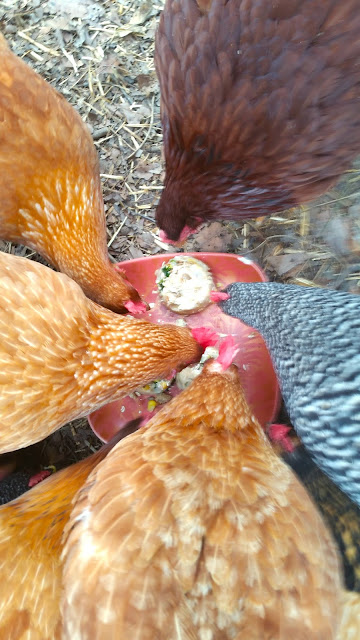The weather is finally starting to warm up again. The first
day of spring has passed, and lighter jackets are relevant once again. All
kinds of spring and Easter events are popping up at community centers and local
churches, and I am ready to emerge from hibernation/nesting mode and get back
into the sunshine!
 |
| "Pretty Boy" and one of the girls |
To the chickens’ delight, the bugs have even started to
appear again, but it was only until recently they weren’t able to find protein
sources without human assistance. We typically feed them their layer feed,
along with a mix of oyster shell for digestion and omega blend for laying, plus
scraps and treats that they enjoy, such as corn and lettuce. Something I
learned to make that is beneficial for them during the colder months, and
convenient to make for me, are suet cakes. They are little “cakes” made of
grease from animal fats- such as bacon and burger grease –with bits of goodies
mixed in. By goodies I mean small pieces of bread, oats, corn, herbs, seeds,
nuts, etc.
 |
| Waiting for their cakes! |
They are easy enough to make, as long as you have enough
grease. That’s what takes time- the collecting of grease. Animal fat is best
from what I’ve read because it’s food waste that would otherwise get thrown out
that can be used to supplement livestock’s diet when they can’t forage for
themselves. We live in a no-food-waste household since having chickens because
they eat just about anything (no citrus or processed sugary foods though). I
have made it a habit to just pour any leftover grease into mason jars once it
has cooled after cooking. This is the only part that takes time, because, for
those of you who know me well enough, I don’t eat a lot of fatty meats or feed
them to my family, so it can be months before I have enough grease to make a
worthwhile batch of cakes. If you want to make suet cakes without animal
products, I have read you can use nut butters, such as peanut butter. I have
not tried, and it sounds messy, but there are vegan options!
I use muffin tins to pour the ingredients into. First, I
decide what I’m going to use as the main ingredients in the cakes. For this
batch, I used corn kernels, herbed croutons, cilantro, sunflower seeds, and
rolled oats. The cilantro is a great natural antibiotic to help the birds fend
off viruses and infections, and the sunflower seeds (other than them being
tasty for any bird) are beneficial to egg production. The corn, croutons, and
oats just provide nutrition that the birds enjoy the taste of (apparently).
They REALLY go crazy for corn!
After choosing my ingredients, I put an even amount of each
into each muffin cup, then pour the liquefied grease on top of each cup to make
the gross, gooey mess you see below. I keep the grease either frozen or in the
back of the fridge while collecting, so keep that in mind if you make these
babies you’d better make sure the grease is soft enough for pouring before
making these. Last step before serving, is to freeze, then you can pop ‘em out
to feed to your birds whenever it’s feeding time, or just as a treat, depending
on what you think they need. I have to make so many more now that we have more
birds, they all fight over them.
 |
| As you can see, the one in the back is a little crumbly. That's okay, they'll eat it right up anyway. |
 |
| Come and get it! |
 |
| Feeding frenzy |
 |
| Pretty Boy likes to eat on his perch |
All the hens have been pretty healthy this winter; a few
were sharing a respiratory virus for a few days, but they all made it through
with minimal intervention. When this does happen, immediately separate the sick
hen from the rest of the flock, then keep them in a warm, dry place while you
make sure they are getting enough to eat and drink. Fluid intake and warmth are
probably the most important factors when nursing a sick hen, we have found. We
did not even administer any store-bought medicine; however, I did make a blend
of cilantro and garlic in purified then boiled and cooled water, which they hated, but we forced it down their
little beaks and I think that really helped them get over the virus. Poor
things had crusties all around their nostrils and eyes and didn’t want to eat. If
you have ever heard a bird sneeze, it is the most adorably pathetic sound!
That being said, if you ever do have a flock and get a sick bird,
some might recommend you get rid of the affected hen right away, meaning kill it. We decided to take the more
humane route, and see if we could nurse our sickies back to health, and we did!
Catastrophe avoided! I’m sure some people who have larger flocks than we do who
don’t want to risk losing their entire livelihood from a cold virus don’t even
want to risk it, but we are still doing this more or less as a hobby until we
gain more experience and might be able to sustain ourselves with the birds even
more, or even make a profit one day.
Only three of the birds have been laying so far with the
warmer weather, but most of our girls are still pretty young. We’re hoping to
see more eggs within the next month or so, though. Then our neighbors will really love us!
 |
| Jumping in excitement for spring! |




No comments:
Post a Comment